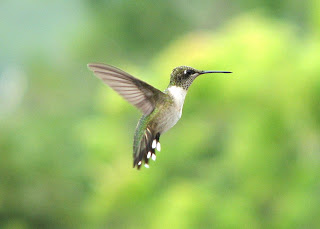Happiness is watching hummingbirds feed. The two that visit our feeders—which is to say, the one that feeds and the one that gets chased away—are resplendent in their shimmering colors, reminding me of the hummingbird in Leslie Marmon Silko’s novel Ceremony. As the Laguna Pueblo author sees it, hummingbirds have a direct connection to the life force.
While the novel is about a World War II veteran (Tayo) who has returned to the reservation with a severe case of PTSD, Silko weaves in a folk story of animal characters in crisis. Tayo’s healing quest parallels the animals’ journey to patch up a quarrel between Corn Woman and Reed Woman. By adapting an old tale to fit current conditions, Silko makes the point that Indian traditions can help heal wounded vets, ravaged native American cultures, and even dominant white culture.
Hard-working Corn Woman complains about how her sister Reed Woman splashes around in a creek all day. Offended, Reed Woman picks up her rain clouds and leaves, causing a drought. The animals must lure her back.
Just as the American work ethic can instrumentalizes nature, blighting our sense of wonder, so Corn Woman must learn to appreciate the joy that Reed Woman takes in her bathing. Similarly, Tayo must reconnect with the earth and with Laguna’s traditions if he is to save himself, his people, and modern technological civilization generally.
A well-fed hummingbird provides the first sign of hope. In the following passage,“Ck’o’yo magic” signifies witchcraft but can also stand in for white men’s ways:
The wind stirred the dust.
The people were starving.
“She’s angry with us,”
the people said.
“Maybe because of that
Ck’o’yo magic
we were fooling with
We better send someone to ask our forgiveness.”
They noticed hummingbird
was fat and shiny
he had plenty to eat.
they asked how come he
looked so good.
He said
Down below
Three worlds below this one
everything is
green
all the plants are growing
the flowers are blooming.
I go down there
and eat
The animals ask hummingbird for help:
“So that’s where our mother went.
How can we get down there?”
Hummingbird looked at all the
skinny people.
He felt sorry for them.
He said, “You’ll need a messenger.
Listen, I’ll tell you
what to do”:
Bring a beautiful pottery jar
painted with parrots and big
flowers.
Mix black mountain dirt
some sweet corn flour
and a little water.
Cover the jar with a
new buckskin
and say this over the jar
and sing this softly
above the jar:
After four days
you will be alive
After four days
you will be alive
After four days
you will be alive
After four days
you will be alive
The green fly that emerges has appeared earlier in the main narrative, an instance of a seeming pest that nevertheless should be treated with respect:
On the fourth day
something buzzed around
inside the jar.
they lifted the buckskin
and a big green fly
with yellow feelers on his head
flew out of the jar.
“Fly will go with me,” Hummingbird said.
“We’ll go see
what she wants.”
they flew to the fourth world
below.
Down there
was another kind of daylight
everything was blooming
and growing
everything was so beautiful.
Note that, in earth-centered religions, heaven is down, not up. Hummingbird and Fly have found the source of renewal, but their job isn’t done yet. Reed Woman demands that the land be purified, and for that they need Buzzard. But Buzzard won’t purify without a gift of tobacco, and for that they need Caterpillar, who gives them what they need:
Hummingbird and Fly thanked him.
They took the tobacco to old Buzzard.
“Here it is. We finally got it but it
sure wasn’t very easy.”
“Okay,” Buzzard said
“Go back and tell them
I’ll purify the town.”
Once Buzzard does his job,
The storm clouds returned
the grass and plants started growing again.
There was food
and the people were happy again.
So she told them
“Stay out of trouble
from now on.
It isn’t very easy
to fix up things again.
Remember that
next time
some ck’o’yo magician
comes to town.”
Tayo too finds his healing center and returns in a way that gives hope to the elders of the village. Ceremony indicates that whites as well as Indians will benefit if they change their relationship to the earth.
And it’s the thrilling hummingbird that alerts us to this possibility!


